Indie Park Review
by Gideon, HSM team writer
It’s not surprising, considering the prolific use of the term “Indie” to vaguely describe just about any type of game from any studio (publisher-backed or not), that PlayStation Home eventually joined in on the misnomery fun and released a space dedicated to Indie games. It could be argued, using one of the many definitions and connotations of the term “Indie”, that PlayStation Home itself is an indie platform. Uncommitted developers have been allowed to make waves in the videogame industry by accessing a readily available audience in PlayStation Home, and although they are treated to the support and guidance of Sony itself, they seem to be largely left to their own devices on the development of Home products.
To further support the efforts of these developers, and perhaps to lure new, untapped talent who might be looking to make a name for themselves, Sony has released the Indie Park in PlayStation Home. This new space is designed to showcase some of the many games in Home in an environment conducive to the stylistc appeal of Indie games. From the grass to the sky, and every game housed between, almost every aspect of Indie Park exudes techno-hip.
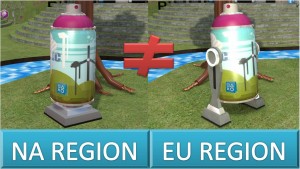 Indie Park first saw the persistent light of day in NA Home’s sister region: EU. Unlike the NA Home, the EU Indie Park is considered to be one of the core spaces of the Hub update. Thankfully the dissimilarities between the two Indie Parks are negligible and the same experience and environment is delivered on both servers. The only differences seem to be the lack of an exit/entrance on the mound at one end of the space and the droidificaiton of the PSN Store spray-can kiosk. There is no indication as to why these unusual differences exist and, surprisingly enough, the lack of the driod spray-can kiosk makes the space a little less lively, if only by a very small margin.
Indie Park first saw the persistent light of day in NA Home’s sister region: EU. Unlike the NA Home, the EU Indie Park is considered to be one of the core spaces of the Hub update. Thankfully the dissimilarities between the two Indie Parks are negligible and the same experience and environment is delivered on both servers. The only differences seem to be the lack of an exit/entrance on the mound at one end of the space and the droidificaiton of the PSN Store spray-can kiosk. There is no indication as to why these unusual differences exist and, surprisingly enough, the lack of the driod spray-can kiosk makes the space a little less lively, if only by a very small margin.
From the moment a user enters the Indie Park they will be stricken with the feeling that something is off, but only in the best of ways. The entirety of the space is contained within a warehouse structure which allows the user to be spatially removed from Home, as if to say that the Indie Park is offering something different from the rest the virtual world. The ground is centrally suspended from the bottom of the warehouse space and is covered in a faux binary that can only be seen from certain angles. This results in a visual whisper of code as the avatar runs across the space, which subtly impacts the overall presentation.
The indie atmosphere inundates the props scattered throughout the space. The walls are littered with backdrops that are decorated with word clouds and spray paint drippings that are meant to make the space look as if it was crafted by talented amateurs and not professional designers. The design choices extends even to the trees, which look to be made of cross sectioned circuit boards. The visual impact of Indie Park lends itself to the techno-hip vibe Sony seems to have been going for.
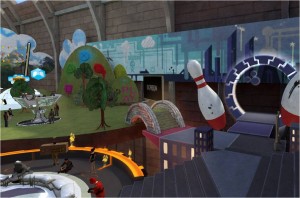 Broken into multiple platforms, the ground shifts from the grass park-like texture to an almost retro industrial setting with solid colors and neon lights. The two separate areas of the space are presented as a day playground and a night cityscape. The sky, locked behind curved beams, gradiates from night to day, which adds to the feeling of displacement and facilitates the overall design of the space. This spatial segregation is accomplished for visual and design purposes alone, as there is no underlying connection between the games in their respective area of the Indie Park.
Broken into multiple platforms, the ground shifts from the grass park-like texture to an almost retro industrial setting with solid colors and neon lights. The two separate areas of the space are presented as a day playground and a night cityscape. The sky, locked behind curved beams, gradiates from night to day, which adds to the feeling of displacement and facilitates the overall design of the space. This spatial segregation is accomplished for visual and design purposes alone, as there is no underlying connection between the games in their respective area of the Indie Park.
In stark contrast to the visuals, the audio of Indie Park leaves quite a bit to be desired. Devoid of any music, the soundtrack of the space is limited to ambient sounds. While each game within the Indie Park has its own music and sounds, visiting Indie Park should only be done with an mp3 player in hand or a mic in ear. This is a shame, because much of Home’s offered musical selection revolves around artists that could be considered to be somewhat independent. The Indie Park doesn’t have to only House Indie games. A kiosk or dance floor showcasing the musical offerings of Home would have been a welcome addition to the otherwise deafening silence of the Indie Park.
Even without an eclectic soundtrack, this digital diorama, consisting of two sections, attempts and gloriously succeeds at creating a feeling of independence from Home. On one side of the space users can explore a digital playground complete with grassy knolls and a persistent 8-bit stream spilling onto the grassy ground and over the side of one of the platforms onto the brick floor below. The flowing, pixilated water is reminiscent of an Indie favorite that has yet to see a release on PSN, Minecraft. Although this is likely an unintentional result of the tapping into the 8-bit revolution with the design of the water stream, it beautifully captures the essence of the Indie games for which the space was named.
The side of the stream where gamers arrive houses a coupling of games from one of Homes favorite developers, nDreams.
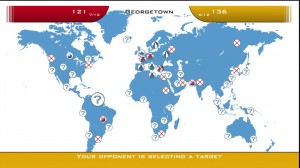 Espionage 9 is a mini-game which summons the spirit of the classic game of Battleship, but cranks the intensity up a couple of notches. In Espionage 9, players begin by placing a Spymaster and a number of saboteurs, agents and double agents around a world map. The gameplay consists of turn based rounds where each player selects spaces from the world map, attempting to find where the opposing forces have been stationed. Most rounds, depending on the location of the pieces, the player is given an update regarding the position of the enemy or the intelligence that has been gathered on them. If a piece is discovered, its benefit is removed, making the remainder of the game more difficult. A round is won when all the opposing pieces are discovered. Espionage 9 is an excellent addition to Home and there is a slew of content that could be built upon this simple spy game of cat and mouse.
Espionage 9 is a mini-game which summons the spirit of the classic game of Battleship, but cranks the intensity up a couple of notches. In Espionage 9, players begin by placing a Spymaster and a number of saboteurs, agents and double agents around a world map. The gameplay consists of turn based rounds where each player selects spaces from the world map, attempting to find where the opposing forces have been stationed. Most rounds, depending on the location of the pieces, the player is given an update regarding the position of the enemy or the intelligence that has been gathered on them. If a piece is discovered, its benefit is removed, making the remainder of the game more difficult. A round is won when all the opposing pieces are discovered. Espionage 9 is an excellent addition to Home and there is a slew of content that could be built upon this simple spy game of cat and mouse.
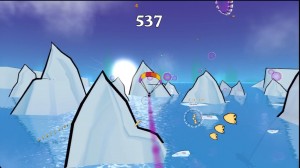 Los Penguini Brothers is a ski-jump para-sailing combination game that whisks the player off to its own space to play with cell shaded penguins. Players choose a penguin with which to play. The penguin is then nudged down a ski slope and launched into the air. There, the player can deploy a parachute and glide around the space through rings, upstream wind currents and floating points until they come to rest in the icy water below or upon a point-giving platform. The player gets three turns per round to try achieve a high score. Los Penguini Brothers is a simple game housed in a robust package. The stylized visuals of the game and advertisement is strikingly different from the rest of Home, which in this case, isn’t necessarily a positive thing.
Los Penguini Brothers is a ski-jump para-sailing combination game that whisks the player off to its own space to play with cell shaded penguins. Players choose a penguin with which to play. The penguin is then nudged down a ski slope and launched into the air. There, the player can deploy a parachute and glide around the space through rings, upstream wind currents and floating points until they come to rest in the icy water below or upon a point-giving platform. The player gets three turns per round to try achieve a high score. Los Penguini Brothers is a simple game housed in a robust package. The stylized visuals of the game and advertisement is strikingly different from the rest of Home, which in this case, isn’t necessarily a positive thing.
Both nDream offerings are limited to weekly freeplays with additional access being sold at a premium price through the static spray-can kiosk.
Back in the Indie Park, gently arching walkways jump the stream, allowing users to visit the other side of the daylight side of the Indie Park. A brick tower housing a selection of gaming cabinets marked as the Arcade section which houses a number of game cabinets. Here gamers can find Home favorites Echochrome and Icebreaker, alongside two new entrants to the arcade cabinet library: Savage Cosmos and Electrokid.
Both cabinet games offer the type of retro gameplay most Indie games try to capture. Savage Cosmos is a top-down shooter where the player moves from room to room across static backgrounds to battle hordes of alien enemies. Electrokid is a classic side scroller in the vein of Commander Keen, where players control an electrically charged boy who must fend off an endless barrage of bullies and scientists. Neither game breaks any boundaries and delivers exactly what is promised, but not much more. Each cabinet can be purchased for personal space use or can be played through token purchases.
While fun retro action is welcomed within Home, it seems as if the term “Indie” is being stretched a bit thin to encompass the games housed within the Arcade. Half of the cabinet games are old Sony developed gems, which fall into the casual game category, and the other half are made by VeeMee, which would rightfully belong in the Indie realm. It’s somewhat surprising to see that Sony elected to keep Scribble Shooter out of the offerings of the Indie park, especially since out of all the cabinets currently available on PlayStation Home, that is the one that best embodies what the Indie game movement is all about.
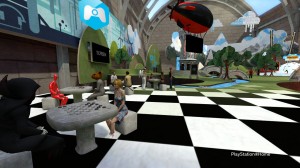 The return of chess and the addition of checkers is displayed as the grass gives way to a checkered floor, mimicking the style of the very boards the games are played on. While it’s a questionable inclusion here, these staples of Home are a welcome addition to the Indie park, since the remodeling of the Mall included the removal of the pubic chess boards.
The return of chess and the addition of checkers is displayed as the grass gives way to a checkered floor, mimicking the style of the very boards the games are played on. While it’s a questionable inclusion here, these staples of Home are a welcome addition to the Indie park, since the remodeling of the Mall included the removal of the pubic chess boards.
Beyond the checkered arena, rigid stairs lead to the darker side of the Park to the industrial cityscape. Beneath the city rumbles a fiery technological beat that radiates an orange glow, giving a juxtaposed tone to the night side of the Indie Park. On this side, users are able to play the VeeMee games of Gnome Curling and Give or Take.
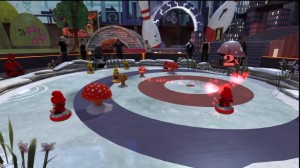 Gnome Curling is a free to play game that puts a cute – or creepy – spin on the classic game of curling; depending on your view of garden gnomes. The player is given a standard gnome curling stone to play the game as many times as they desire. If a player wishes, they are able to buy more powerful curling stones in the PlayStation store. There is also a personal game space that is available to those who wish to have Gnome Curling available to them at any time. This may be beneficial to fans of the game, since the EU Indie Park has switched its Gnome Curling out for Cogs.
Gnome Curling is a free to play game that puts a cute – or creepy – spin on the classic game of curling; depending on your view of garden gnomes. The player is given a standard gnome curling stone to play the game as many times as they desire. If a player wishes, they are able to buy more powerful curling stones in the PlayStation store. There is also a personal game space that is available to those who wish to have Gnome Curling available to them at any time. This may be beneficial to fans of the game, since the EU Indie Park has switched its Gnome Curling out for Cogs.
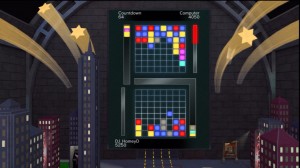 Give or Take is a two player competitive casual Tetris bubble popping hybrid game. Each player is assigned a side of the board and take turns dropping colored bricks onto the bottom of the screen or launching them to the top of the screen from a center bar. Players who complete a series of four or more bricks of the same color causes that series to disappear. Since the player is able to drop blocks on either side of the screen, players are able to – if they wish – play a devious offensive game involving the thwarting of their opponents ability to complete sequences. What seems to be a simple game can end up being a vindictive and heated trial of wits and will.
Give or Take is a two player competitive casual Tetris bubble popping hybrid game. Each player is assigned a side of the board and take turns dropping colored bricks onto the bottom of the screen or launching them to the top of the screen from a center bar. Players who complete a series of four or more bricks of the same color causes that series to disappear. Since the player is able to drop blocks on either side of the screen, players are able to – if they wish – play a devious offensive game involving the thwarting of their opponents ability to complete sequences. What seems to be a simple game can end up being a vindictive and heated trial of wits and will.
The industrial side of Indie park is rounded out with the entranceway to the classic Home staple, the Bowling Alley.
With the exception of Give or Take, each new game in the Indie Park is subject to a pay-to-play model. Gnome Curling is free to play but offers upgrades to the game via micro transactions and a personal space, which is a nice touch. Electrokid and Savage Cosmos both follow the coin-op model of classic arcade machines with tokens that are available in the store. A player could, if they wish, purchase the cabinet for their personal space and forgo the pay-per-play of the coin-op option. Without paying for tokens, or buying one of the cabinets, there is no way for an individual player to play the offerings of these two new cabinet games. Los Penguini Brothers and Espionage 9 work on a proprietary ticketing system for each game, offering their own independent payment options. This leads us to the largest problem with the Indie Park.
There are far too many payment options for it to be considered even close to reasonable.
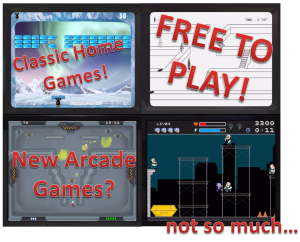 Adding to the Indie Park coin-op payment system is the individual ticket model being used for Espionage 9 and Los Penguini Brothers. These games are excellent additions to Home and their existence truly enriches an already diverse gaming landscape, but the payment required for play seems unbalanced. Users are not only being asked to pay for each game individually. but are being given only one free play per week. While this one free play may keep gamers returning each week to get their shot at each game, the fact that each game has their own set of tickets that need to be purchased seems cumbersome at best.
Adding to the Indie Park coin-op payment system is the individual ticket model being used for Espionage 9 and Los Penguini Brothers. These games are excellent additions to Home and their existence truly enriches an already diverse gaming landscape, but the payment required for play seems unbalanced. Users are not only being asked to pay for each game individually. but are being given only one free play per week. While this one free play may keep gamers returning each week to get their shot at each game, the fact that each game has their own set of tickets that need to be purchased seems cumbersome at best.
As mentioned previously, Gnome Curling and the cabinets offer purchasable spaces and items that gain the player access to the full game that require no further cost on the part of the player. This type of free to play with purchasable upgrades offer would have been appreciated for more robust games such as Espionage 9 and Los Penguini Brothers. Neither game offers such an option. Each additional play costs tickets, and tickets cost money.
Having multiple games with multiple payment systems and multiple accessibility capabilities makes for a confusing, frustrating and all together sloppy gaming environment. For five games there four payment options. While it’s true that a single play of a game a such as Espionage 9 or Los Penguini Brothers is worth more than a single play on a cabinet based games, it isn’t true that every game cannot utilize the same payment method. The transaction system ought to take the coin-op model for all its worth and charge multiple tokens for more robust games, just as actual arcade cabinets do. This coin-op method could even be limited to plays performed within the confines of the Indie Park itself, so that the coin-op model doesn’t spill outside the confines of one single space, inadvertently creating a pseudo-standard currency.
Wild conceptualizations aside, the Indie Park would have better been served by standardizing how games are offered within its virtual brick walls, even if the standards are relegated just to the Indie Park.
The sting of the payment options is somewhat offset by the rewards being offered by each of the pay-to-play games in the Indie Park. From t-shirts to hats, each of the new games, except for Give or Take, rewards players for their efforts and coins. Interestingly enough, the most interesting rewards seem to come from Gnome Curling, a game that is free to play.
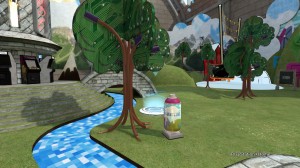 By far, the delivered aesthetic design is the most appealing aspect of the Indie Park. Every aspect of the space has been carefully and deliberately crafted to give the Indie Park a surreality that makes it unique in Home. Its design takes into account the characteristics of Indie games that make them so appealing to the average gamer. It’s simple in concept, but carries with it a personality that is all its own. Even with its exceptional appeal, the Indie Park manages to engrosses the visitor in a world that is congruent with Home’s total experience by offering a wide range of gaming entertainment. Nevermind that the games offered within the Indie Park are stretching the definition of Indie to its absolute limits, they’re each an enjoyable experience in their own right.
By far, the delivered aesthetic design is the most appealing aspect of the Indie Park. Every aspect of the space has been carefully and deliberately crafted to give the Indie Park a surreality that makes it unique in Home. Its design takes into account the characteristics of Indie games that make them so appealing to the average gamer. It’s simple in concept, but carries with it a personality that is all its own. Even with its exceptional appeal, the Indie Park manages to engrosses the visitor in a world that is congruent with Home’s total experience by offering a wide range of gaming entertainment. Nevermind that the games offered within the Indie Park are stretching the definition of Indie to its absolute limits, they’re each an enjoyable experience in their own right.
The inclusion of casual games such as the Bowling Alley, chess and checkers in the Indie Park shows a slight misunderstanding of what indie games actually are and what they can mean for the gaming community. Coupling casual games under the Indie genre label is akin to coupling Home with MMORPG. While an uneducated glance might confuse them, those with knowledge of each would understand that there are vast differences. Of course, the impact of this misunderstanding is ultimately positive as these casual games feel right at home in this new space, pun intended.
It wouldn’t be completely surprising to see the Indie Park evolve into a sort of unofficial center of Home. With its techno-hip vibe and relaxed atmosphere, the Indie Park is a great place to meet friends and just hang out. The games, which will most likely be swapped out for new offerings from time to time, will keep players coming back for more. The addition of classic Home offerings such as Bowling and Chess will help the Indie Park find a place in the hearts and schedules of many long-time Home users.
So, the next time a Home player gets an itch for a unique and interesting Home gaming experience, all they’ll have to do is visit the Indie Park and be willing to pony up some coin.


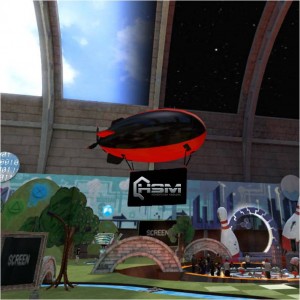




I posted some time back that I wanted a park. This isn’t it but it is kind of neat even if one doesn’t play the games.
A change of space (sic) that’s nice to walk around in.
I only played one game, gnome curling once, and I managed to tie my opponent. I didn’t know it was a partial game and if in playing it again I enjoy it and figure out how to play, I might buy one of the gnomes or whatever one needs. Come to think of it, the curling game was fun enough even though I don’t know how to play.
It’s a digital space and it looks like it however that’s quite all right. It’s worth looking into further and who knows? I might even buy the gnome private space.
Nice article.
I like the Tetris type game, it is ok and the gnome curling is really silly and fun too. I can take or leave the penguins and arcade games, they didn’t impress me much. I think the space for itself is well wrought but I doubt I will spend much time there.
Good job on the review Gid as always, I think you hit the nail on the head.
Man, what a good review! I think we could sell this like those guides you buy! I really like the Indie park. I think it is going in the right direction, lots and lots of games! Many times you’re solo on Home and this is a great way to have fun. Great article!
Thanks for the positive feedback guys. Burbie, I TOTALLY agree about the penguin game. I initially considered reviewing each game with this review but thought that would make this article too robust and cumbersome for the reader and the reviewer (me). I felt the Los Penguni Bros was sort of an odd addition to Home, why didn’t they allow us to use our avatars for this game? The fact that it’s a separate space makes me think this might have been a better “table-top” game for users where this game was in a Los-Penguni space that users could visit (a la mod-nation).
Every time I read a review by you I want to curl up in a ball and cry because you do such an awesome job. You are really gifted with your ability to articulate..Awesome job with this Gideon…